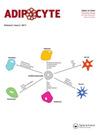An organoid model derived from human adipose stem/progenitor cells to study adipose tissue physiology
IF 3.5
4区 生物学
Q2 ENDOCRINOLOGY & METABOLISM
引用次数: 9
Abstract
ABSTRACT We established a functional adipose organoid model system for human adipose stem/progenitor cells (ASCs) isolated from white adipose tissue (WAT). ASCs were forced to self-aggregate by a hanging-drop technique. Afterwards, spheroids were transferred into agar-coated cell culture dishes to avoid plastic-adherence and dis-aggregation. Adipocyte differentiation was induced by an adipogenic hormone cocktail. Morphometric analysis revealed a significant increase in organoid size in the course of adipogenesis until d 18. Whole mount staining of organoids using specific lipophilic dyes showed large multi- and unilocular fat deposits in differentiated cells indicating highly efficient differentiation of ASCs into mature adipocytes. Moreover, we found a strong induction of the expression of key adipogenesis and adipocyte markers (CCAAT/enhancer-binding protein (C/EBP) β, peroxisome proliferator-activated receptor (PPAR) γ, fatty acid-binding protein 4 (FABP4), adiponectin) during adipose organoid formation. Secreted adiponectin was detected in the cell culture supernatant, underscoring the physiological relevance of mature adipocytes in the organoid model. Moreover, colony formation assays of collagenase-digested organoids revealed the maintenance of a significant fraction of ASCs within newly formed organoids. In conclusion, we provide a reliable and highly efficient WAT organoid model, which enables accurate analysis of cellular and molecular markers of adipogenic differentiation and adipocyte physiology.从人脂肪干细胞/祖细胞衍生的类器官模型用于研究脂肪组织生理学
摘要:我们建立了从白色脂肪组织(WAT)中分离的人脂肪干细胞/祖细胞(ASCs)的功能性脂肪类器官模型系统。通过悬滴技术迫使ASCs自聚集。之后,将球体转移到琼脂包被的细胞培养皿中,以避免塑料粘附和解聚。脂肪细胞分化是由脂肪生成激素鸡尾酒诱导的。形态计量学分析显示,在脂肪形成过程中,直到18 d,类器官的大小显著增加。用特异性亲脂性染料对类器官进行全载染色,发现分化细胞内有大量的多室和单室脂肪沉积,表明ASCs向成熟脂肪细胞的高效分化。此外,我们还发现,在脂肪类器官形成过程中,关键脂肪生成和脂肪细胞标志物(CCAAT/增强子结合蛋白(C/EBP) β、过氧化物酶体增殖物激活受体(PPAR) γ、脂肪酸结合蛋白4 (FABP4)、脂联素)的表达受到强烈诱导。在细胞培养上清中检测到分泌的脂联素,强调了成熟脂肪细胞在类器官模型中的生理相关性。此外,胶原酶消化的类器官的集落形成试验显示,在新形成的类器官中维持了相当一部分ASCs。总之,我们提供了一个可靠和高效的WAT类器官模型,可以准确分析脂肪形成分化和脂肪细胞生理学的细胞和分子标记。
本文章由计算机程序翻译,如有差异,请以英文原文为准。
求助全文
约1分钟内获得全文
求助全文
来源期刊

Adipocyte
Medicine-Histology
CiteScore
6.50
自引率
3.00%
发文量
46
审稿时长
32 weeks
期刊介绍:
Adipocyte recognizes that the adipose tissue is the largest endocrine organ in the body, and explores the link between dysfunctional adipose tissue and the growing number of chronic diseases including diabetes, hypertension, cardiovascular disease and cancer. Historically, the primary function of the adipose tissue was limited to energy storage and thermoregulation. However, a plethora of research over the past 3 decades has recognized the dynamic role of the adipose tissue and its contribution to a variety of physiological processes including reproduction, angiogenesis, apoptosis, inflammation, blood pressure, coagulation, fibrinolysis, immunity and general metabolic homeostasis. The field of Adipose Tissue research has grown tremendously, and Adipocyte is the first international peer-reviewed journal of its kind providing a multi-disciplinary forum for research focusing exclusively on all aspects of adipose tissue physiology and pathophysiology. Adipocyte accepts high-profile submissions in basic, translational and clinical research.
 求助内容:
求助内容: 应助结果提醒方式:
应助结果提醒方式:


